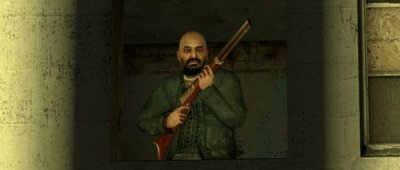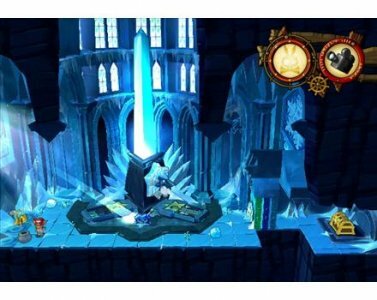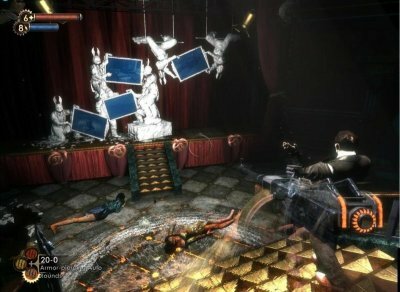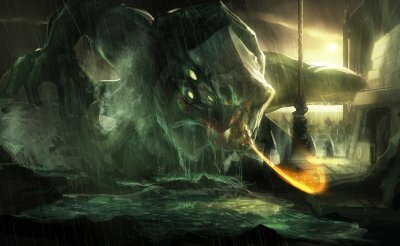Good levels comprise numerous factors, all equally important. Visual appeal, good pacing, intriguing puzzles and interesting fights are all critical components in making good levels. Great levels, however, are defined by three important qualities: visibility, telling a story and accomplishment.
Visibility
Visibility refers to a player’s ability to clearly understand the goal, his ability to follow his progress towards that goal, and his ability to form the intentions needed to achieve the goal.
Clear Goals
Without a clear goal the player is lost. If you lose your player, he WILL put down the controller and quickly find something else to entice him. Note that being lost is different than having a mystery to solve.
Mystery: “Hmm, how do I get up to that ledge over there?” (Have a goal, but not the solution)
Lost: “Where the fuck am I supposed to go?” (No goal)
Goals are the big picture, intentions are the steps you must take to reach that goal. Ravenholm from Half Life 2 requires that the player get from one side of the city to the other. You have a clear goal. You know why you are there and where you going, just not how to get there. Soon you encounter Grigori the Priest, who changes your intention, but not your goal.

He adds humor to a bleak situation
Grigori’s Church act as a visual reminder of your goal, and he reappears at various points to remind you of your goal. When he reappears he also serve a second, equally valuable purpose, which is to give the player his progress to his goal.
Progress
Good feedback is critical to good design. As the player takes steps to her goal, she must be updated about her progress. A player’s progress can be shown several ways: through other characters (Grigori in Ravenholm), through UI elements (quests in WoW), or through visual indications in the world (restoring nature in Okami). If you do not give feedback, the player may believe that her actions are ineffectual, or worse incorrect.
Imagine the player is trapped in a room with skeletons. Her goal is to escape through a door, unlocked by killing three skeletons. Even if given no update on her progress, a simple set up like this wouldn’t be too frustrating; however, the more complex the set up, the more feedback is required. Now that the room is filled with skeletons and werewolves. The door is unlocked by killing three werewolves. Without feedback this set up is unplayable. What if the player kills 1 Werewolf and 20 skeletons? When the player kills the werewolf, the door must give clear signs to her that her actions are correct. This not only shows her progress to her goal, but also acts as reinforcement of correct behavior. If there are three lights over the door which light up as werewolves are killed, the player will understand killing werewolves is good, more than this, it will show her that she only has to do it two more times.
Forming Intentions
The trickiest part about a puzzle is giving the player just enough information so he can solve it, but not so much he feels cheated. The player must always be able to understand what pieces he can work with, but not the where, how, or order he should use them.
- Wrong: A floor tile that looks like every other, when stepped on, opens a door
- Good: A door with the face of a gryphon matches a floor tile with the same symbol. Stepping on the tile opens the door.
- Better: A door has symbols for a gryphon, lion, and snake. There are three floor tiles with the same faces, and stepping on the tiles in the correct sequence opens the door.

My favorite puzzle from zack and wiki has great visibility
Taking the example of skeletons and werewolves, if the player is required to kill three werewolves in a specific location, the room needs clear indicators of what makes this section of the room special and it needs to indicate that this special location is related to the door. Remember, the player MUST know the pieces. Not knowing the pieces of the puzzle makes the player hate your game (or worse themselves). The better you show the pieces, the more satisfied when they solve the puzzle.
There is a ring on the ground of an otherwise plain and unadorned room. When a werewolf is killed within the ring, a light above the door comes on.
The room clearly shows that there is something different about this spot in the room, but everything else about this set up is painfully wrong. Some basic problems: the ring has no connection to the door, the reason it needs to be werewolves is not clear, and the progress feels disconnected from your actions.
In the center of the room is a ring cut into the ground. A groove runs from the ring to a door. Around the door are three stone werewolf heads, their mouths clamped on three crossbars, keeping the door closed. When a werewolf is killed within the ring, a werewolf opens its mouth and one of the crossbars slides free of the door.
We can still improve the design. The player can see there is something different about this ring in the center of the room, and a groove running to the door gives him a sense they are connected. Using werewolf heads to block the door connects his actions to his result, but there still is no clear reason why we can only kill werewolves and not skeletons.
In the center of the room is a shallow, circular pool of blood. A groove runs from the pool to a door. Around the door are three stone werewolf heads, their mouths clamped on three crossbars, keeping the door closed. When a werewolf is killed within the pool, blood runs through the groove on the ground up to the door. When the blood reaches the door a werewolf opens its mouth, blood oozing from its open mouth, and one of the crossbars slides free of the door.
Since skeletons lack blood, this now gives us a reason we must kill the werewolves and not the skeletons. The player now has all of the pieces necessary to form the intentions needed to achieve his goal.
Telling a story
A game tells a story through its levels. In great games, levels tell their own stories. A level that tells a story has character, has interesting and relevant moment-to-moment scenarios, and has experiences that draw the player into the game. Fort Frolic from the original Bioshock is a wonderful, powerful example of a level telling its own story.To remove Sander Cohen from that level is to pull out the very essence:

- With Sander Cohen: A crazy artist prevents you from leaving. He will let you pass, but first you must murder his disciples, take a picture of their body, and place the picture of their murdered corpse into his greatest masterpiece.
- Without Sander Cohen: Kill three guys to unlock a door.
In both cases the player is performing the same task – kill three guys to progress the story. The former, however, is wrapped up in a brilliant package that increases the player’s feeling of accomplishment.
It should go without saying, I feel I must anyway, that in order for this to be effective, the story the level tells must fit within the mythos and major arc of the story your game is telling. If it is incongruous or antithetical, you will only pull the player out of the experience. How to be a competent writer and storyteller is beyond the scope of this piece, nor would I bother as I am neither. The point is to understand the power of storytelling within your own level as a means to give you access to scenarios, puzzles, and fights that would otherwise feel out of place, bland, or lack accomplishment.
Accomplishment
It took me a long time to realize that when designing a level it’s not about making it hard, or difficult, or mighty, or over the top. It’s about making the player feel like he has accomplished something. Accomplishment comes in many forms: solving a grand puzzle, defeating a large opponent, or overcoming a hated adversary. God of War excels in generating that feeling of accomplishment. Larger than life bosses, grand vistas and reveals of places you have come from, and interactions/puzzles that meaningfully shape and change the world enrapture the player with deep feelings of accomplishment. Note: it is important to understand that accomplishment is not the same as perseverance and it is not the player struggling against a frustrating situation. Yes, overcoming a challenge is wonderful. That feeling of killing that hydra, solving that puzzle, finding that buried treasure, that is what you are looking for; however, there is a stark difference between challenging and frustrating. Do not get caught in the trap of trying to “outsmart” your players.
Our job is not to prove to the player how fucking smart we are. Seriously.

She does little damage, but the player doesn’t notice or care
We want players thinking how smart THEY are. The player can and should be challenged, but never frustrate them. One of my favorite questions to designers is to ask for the difference between challenging and frustrating. I have heard several different answers, but I like to break it down like this:
- Challenged: I am mad at myself
- Frustrated: I am mad at the game
You are challenged when the pieces are exposed (visibility!) but just lack the right sequence. Without visibility you are frustrated, you feel lost. Remember, we are not designing games for ourselves, we are designing them for other people. “What!” You baulk. “I’ve played tons of games. I love them, and I KNOW what’s fun and what isn’t.” Sorry, no. You really and truthfully couldn’t be more wrong.
My good friend and I, we have this saying. We call it, “Our One Thing”. It is our goal to one day design and put into the game something that remains untouched, unblemished by revision, for the entire project. We have yet to have our one thing, and I don’t know a single designer who has. This is a GOOD thing. Every change was always for the better, and always with the eye on the end user experience. Always try to share your designs with your peers as often as you can, and do not be afraid if your idea flops. It won’t be the first and it won’t be the last. Go back to it; rework it; enliven it. Ask yourself if all the pieces are where they should be. Visibility is key in transforming frustrating scenarios into challenging ones.